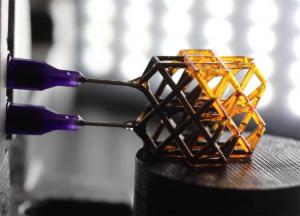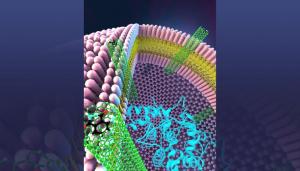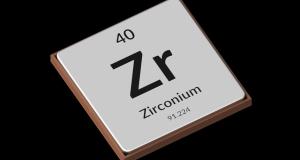LAB REPORT
Science and Technology Making Headlines
Jan. 11, 2019

LLNL scientists have found that mid-latitude regions of Northern Hemisphere continents have a large seasonal cycle of atmospheric temperature, with frigid winters and hot summers. Satellite temperature data are consistent with models that project that this seasonal "heartbeat" is becoming stronger with human emissions of carbon dioxide.
Seasons greetings
For the first time, scientists from Lawrence Livermore National Laboratory and five other organizations have shown that human influences significantly impact the size of the seasonal cycle of temperature in the lowest layer of the atmosphere.
To demonstrate this, they applied a so-called “fingerprint” technique. Fingerprinting seeks to separate human and natural influences on climate. It relies on patterns of climate change – typically patterns that are averaged over years or decades. But in the new research, the team studied seasonal behavior and found that human-caused warming has significantly affected the seasonal temperature cycle.
The researchers focused on the troposphere, which extends from the surface to roughly 16 kilometers in the atmosphere at the tropics and 13 kilometers at the poles. They considered changes over time in the size of the seasonal cycle of tropospheric temperature at different locations on the Earth’s surface. This pattern provides information on temperature contrasts between the warmest and coldest months of the year.


Though there is a 1 in 2,700 chance of it happening, Bennu could easily destroy a city like London should it hit Earth.
Just a century away
Bennu is a 500-meter-wide monster of an asteroid and there’s a tiny risk it will plough into Earth and do some serious damage in the next century.
A NASA spacecraft has entered orbit around the asteroid, which is 70 million miles from Earth, and is soaring roughly a mile above its surface. In 2020, the NASA craft will collect samples of the rock and attempt to return them to Earth in 2023.
If a disastrous impact came to pass, it would release more energy than all the nuclear weapons detonated in the entirety of human history. Bennu is as wide as five football fields and weighs around 79 billion kilograms, which is 1,664 times heavier than the Titanic.
It has a 1 in 2,700-chance of striking Earth between 2175 and 2199. In a study, academics who work alongside NASA as part of the planetary defense team ultimately concluded that using a single HAMMER (Hypervelocity Asteroid Mitigation Mission for Emergency Response) vehicle spacecraft as a battering ram would prove inadequate for deflecting an object like Bennu.
"The consequences would be dire," said Kirsten Howley, a physicist at Lawrence Livermore National Laboratory who is part of the planetary defense team. “This study aims to help us shorten the response timeline when we do see a clear and present danger so we can have more options to deflect it. The ultimate goal is to be ready to protect life on Earth.”


Researchers injected a magnetorheological fluid into hollow lattice structures built on LLNL’s Large Area Projection Microstereolithography platform, which 3D prints objects with microscale features over wide areas using light and a photosensitive polymer resin. Photo by Julie Jackson Mancini.
Metamaterials on the fly
Lawrence Livermore frequently does impressive work with 3D printing materials, including metamaterials. Now the Lab has introduced a new class of metamaterial that can almost instantly respond and stiffen 3D printed structures when exposed to a magnetic field.
LLNL calls the materials “field-responsive mechanical metamaterials” or FRMMs. They involve a viscous, magnetically responsive fluid that is injected into the hollow struts and beams of 3D-printed lattices. Unlike other 4D printed materials, the FRMMs’ overall structure does not change. The fluid’s ferromagnetic particles located in the core of the beams form chains in response to the magnetic field, stiffening the fluid and the lattice structure. This happens in less than a second.
The stiffening of the fluid and, in turn, the 3D-printed structures, is reversible and tunable by varying the strength of the applied magnetic field.
"What’s really important is it’s not just an on and off response; By adjusting the magnetic field strength applied we can get a wide range of mechanical properties,” said Julie Jackson Mancini, an LLNL engineer who has worked on the project since 2014. “The idea of on-the-fly, remote tunability opens the door to a lot of applications.”


An artist’s representation of a block copolymer vesicle with carbon nanotube porins embedded in its walls. Image by Ella Maru Studios.
Nanoutbes follow in Mother Nature’s footsteps
Cellular membranes serve as an ideal example of a system that is multifunctional, tunable, precise and efficient.
Efforts to mimic these biological wonders haven’t always been successful. However, Lawrence Livermore scientists have created polymer-based membranes with 1.5-nanometer carbon nanotube pores that mimic the architecture of cellular membranes.
Carbon nanotubes have unique transport properties that can benefit several modern industrial, environmental and biomedical processes — from large-scale water treatment and water desalination to kidney dialysis, sterile filtration and pharmaceutical manufacturing.
Taking inspiration from biology, researchers have pursued robust and scalable synthetic membranes that either incorporate or inherently emulate functional biological transport units. Recent studies demonstrated successful lipid bilayer incorporation of peptide-based nanopores, 3D membrane cages and large and even complex DNA origami nanopores.
LLNL scientists went one step further and combined robust synthetic bloc-copolymer membranes with another LLNL-developed technology: artificial membrane nanopores based on carbon nanotube porins (CNTPs), which are short segments of single-wall carbon nanotubes that form nanometer-scale pores with atomically smooth hydrophobic walls that can transport protons, water and macromolecules, including DNA.


An isotope of the element zirconium absorbs neutrons with a fervor unrivaled by almost any other type of known atom.
Element soaks up neutrons like a sponge
When Lawrence Livermore radiochemists and their colleagues got the first results of their experiment, no one expected what they saw: Atoms of a weird version of the element zirconium had enthusiastically absorbed neutrons.
The source of this fuss was zirconium-88. That’s a particular type, or isotope, of zirconium, distinguished by the number of neutrons it contains. Garden-variety zirconium typically contains about 50 neutrons, but zirconium-88, which is radioactive and not found naturally on Earth, has fewer than normal, with 48 neutrons.
When irradiated with low-energy neutrons from a nuclear reactor, each atom of zirconium-88 had a high probability of absorbing a neutron into its nucleus, causing the element to transform into another isotope, zirconium-89. The reaction was about 85,000 times as likely to occur as predicted.





